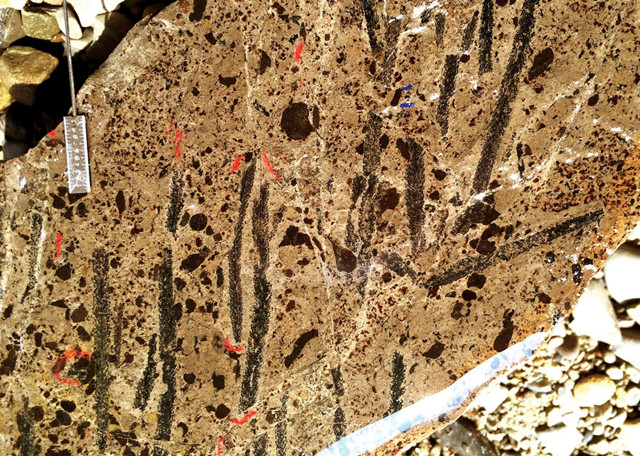
by Bethany Augliere Tuesday, November 15, 2016

These fossilized shallow-water graptolites found in Nevada are from the Ordovician. Credit: Charles E. Mitchell.
Changes in our modern ecosystems, such as declines in biodiversity and invasive species, are similar to those that preceded the first of Earth’s mass extinctions about 443 million years ago, according to a new study. Researchers recently found that ancient plankton communities began to show environmental stress nearly 400,000 years before the extinction, as the planet cooled.
About 85 percent of marine life vanished during the Late Ordovician. “Some people claim that mass extinctions are [only] driven by abrupt cataclysmic events,” says H. David Sheets, an interdisciplinary researcher at Canisius College in Buffalo, N.Y., and co-author of the study, published in Proceedings of the National Academy of Sciences. “What we’re seeing in the Ordovician is that it really looks like it was driven by climate change.”
The research team collected, examined and identified roughly 24,000 fossils, primarily from the outcrops of former sea beds in parts of Nevada and the Yukon in Canada, and also used information from data collections at 17 other sites. They focused on communities of graptolites — a type of colonial zooplankton that was abundant in the Ordovician and is now extinct — that occupied either the deep or shallow regions of the ocean’s water column. The goal: to determine relative species abundance before and during the extinction, which few studies have done, says Peter Wagner, a paleobiologist at the Smithsonian National Museum of Natural History who was not involved in the research. “The findings almost had to be novel,” he says.
To answer their questions, the researchers had to address two challenges: the water depth associated with each graptolite species, and the change in water depth over time at various locations. As sea levels change through time, habitats shift laterally through the rock. “When you look through the column, it’s not just a record through time, but you are actually sampling different environments through time as well,” says Steve Holland, a paleontologist at the University of Georgia who was not involved with the study. “So it becomes really tough to tell, what’s the faunal change because there was an extinction and what’s the faunal change because we are sampling a different environment.” To combat that, Sheets’ team utilized a proxy, neodymium isotope levels in the rock record, to determine water depth at each study site. “I’d like see a lot more studies that take this kind of approach,” Holland notes.
Next, they had to determine if a species normally lived in deep or shallow water. They used statistical models that found the probability of a species occurring at a specific depth. As the extinction approached, they found that rarer species disappeared from the deepwater community and more invasive organisms moved in, including the Neograptina, a group of graptolites previously limited to higher latitudes. This work fits the idea that “specialists get hit harder,” Wagner says.
Sheets says that the change in communities is related to climate change. At the end of the Ordovician Period, the planet was transitioning from a period of warm temperatures to cooler ones, with the onset of glaciation. Ocean circulation changed and fewer nutrients were available in deep water for those specialist graptolites. “This one whole segment of the graptolite community was seeing their way of life disappear,” he says. By examining the fine details of the community, such as species abundance and population size, Sheets and the team could see signs of stress long before the actual extinction, due to these alterations in the ocean. And it’s something to take seriously in our modern world, he notes.
That’s because it’s happening today, according to Holland. Ecosystems are experiencing influxes of invasive species and changes in biodiversity, such as evenness — parity in the relative abundance of species in an area, Holland says. “And what it suggests is that we may well be on the path to a major mass extinction.”
© 2008-2021. All rights reserved. Any copying, redistribution or retransmission of any of the contents of this service without the expressed written permission of the American Geosciences Institute is expressly prohibited. Click here for all copyright requests.